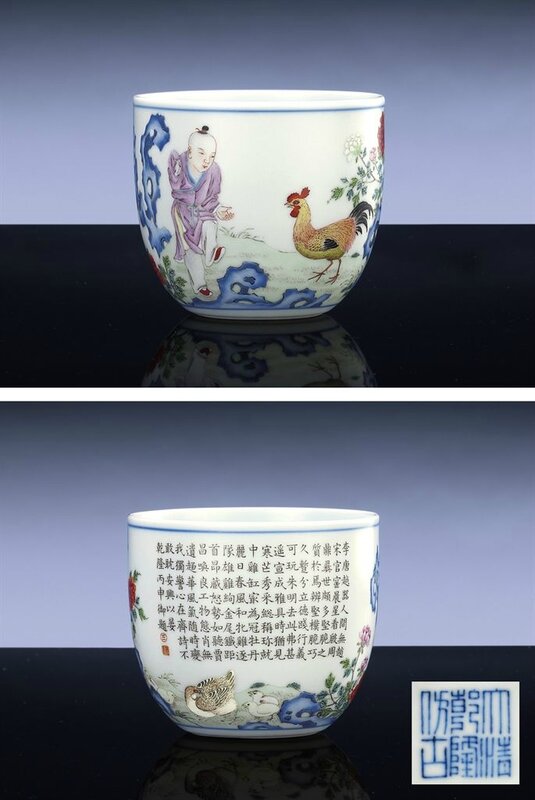The deep U-shaped body finely painted with the scene of Jia Chang stamping his left foot to call the chickens in a setting of blue rocks and peonies, the boy depicted facing the rooster while the hen and four chicks are shown to the reverse beneath a poetic inscription.
Provenance: A Japanese private collection
Christie's London, 4 November 2008, lot 222
Note: Compare with an example in the Palace Museum collection, Beijing, included in the exhibition The Life of Emperor Qianlong, Macao Museum of Art, Macao, 2002, and illustrated in the Catalogue, no. 90. A pair of bowls of the same design in the National Palace Museum, Taipei were included in the exhibition K'ang-hsi, Yung-cheng and Ch'ien-lung Ware from the Ch'ing Dynasty, National Palace Museum, Taipei 1986, illustrated in the Catalogue, no.144.
Cups of this type are based on earlier Chenghua doucaiprototypes such as the pair of cups of similar shape, but decorated with chickens only, included in the Illustrated Catalogue of Chinese Government Exhibits for International Exhibition of Chinese Art in London, vol. II, Porcelain, 1948, p. 130, no. 171.
The mark on the base of all of these cups reads Da Qing Qianlong fanggu, which translates as 'made in imitation of antiquity in the Qianlong reign of the Great Qing dynasty'. The imitation of antiquity, or archaism, was a theme close to the Qianlong emperor's heart and a considerable number of imperial art objects in a range of different media bear this mark. The correct rendering of the mark was given by D. Howard and J. Ayers when they included a similar cup in their catalogue of the Mottahedeh collection, Chinese for the West, London/New York, 1978, vol. 1, pp. 171-2, no. 165, in which they date the cup to the Qianlong reign. A cup of this type was also published as dating to the Qianlong period by S. Bushell, who translated the poem in Oriental Ceramic Art, New York, 1899, pp. 49-51.
The poem is in praise of well-known works of art from earlier periods and in particular to Ming dynasty chicken cups. As with most of Qianlong's poems, there are many archaic references. In this instance, the Emperor mentioned the child prodigy, Jia Chang (b. AD713), as depicted by the image of the boy on the present cup. At the age of thirteen, Jia Chang was such a talented trainer of fighting cocks that the Tang dynasty emperor Xuanzong (r. AD 713-56) employed him to train the imperial fighting cocks. The design on these cups is therefore often known as 'the precocious boy'.
Christie's. The Imperial Sale Important Chinese Ceramics and Works of Art, 31 May 2010, Hong Kong

/https%3A%2F%2Fprofilepics.canalblog.com%2Fprofilepics%2F1%2F0%2F100183.jpg)
/https%3A%2F%2Fstorage.canalblog.com%2F03%2F02%2F119589%2F96711876_o.jpg)
/https%3A%2F%2Fstorage.canalblog.com%2F11%2F31%2F119589%2F94773502_o.jpg)
/https%3A%2F%2Fstorage.canalblog.com%2F20%2F83%2F119589%2F94772815_o.jpg)
/https%3A%2F%2Fstorage.canalblog.com%2F26%2F72%2F119589%2F75604929_o.jpg)
/https%3A%2F%2Fstorage.canalblog.com%2F59%2F60%2F119589%2F26458628_o.jpg)



/http%3A%2F%2Fstorage.canalblog.com%2F91%2F48%2F119589%2F128923043_o.jpg)
/http%3A%2F%2Fstorage.canalblog.com%2F84%2F09%2F119589%2F128922928_o.jpg)
/http%3A%2F%2Fstorage.canalblog.com%2F74%2F57%2F119589%2F128709421_o.jpg)
/http%3A%2F%2Fstorage.canalblog.com%2F96%2F72%2F119589%2F128683141_o.jpg)